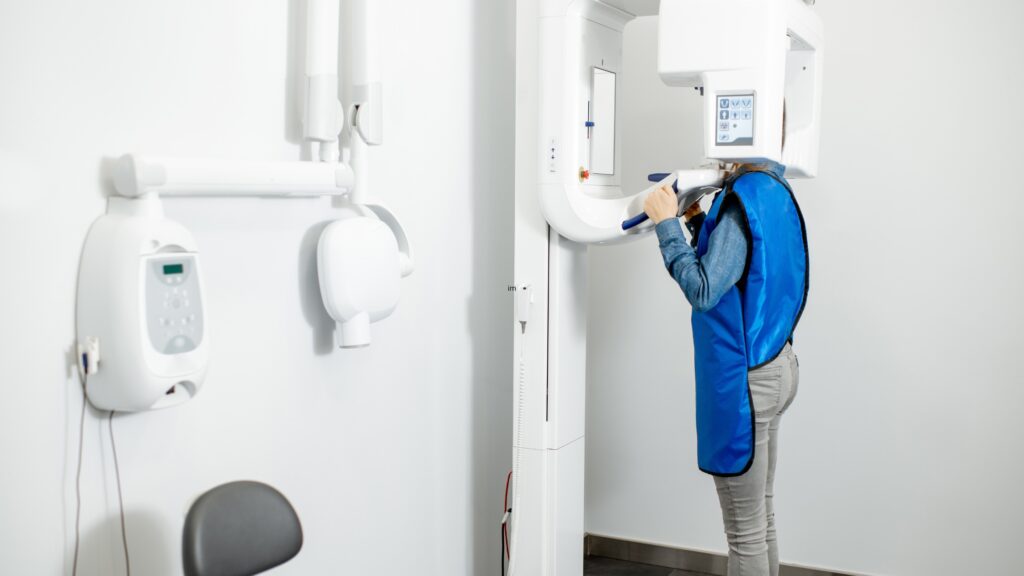
Dosimeter badge services for medical, dental, and veterinary businesses
Learn how Radiation Detection Company’s easy-to-use dosimetry solutions can boost the efficiency of your practice.

Dosimetry Consultant
Last Updated: October 18, 2024
Explore the fundamental precept of radiation safety (ALARA), its history, and the three principles that reduce radiation exposure to occupational personnel and the public alike.
Radiation safety is built on the foundation of "ALARA." You may have heard the word used before, but what does it mean? And how does ALARA affect employees working with radioactive material and radiation-emitting equipment?

The main principle of radiation safety is "ALARA." ALARA stands for "as low as reasonably achievable." A radiation safety program aims to keep worker radiation doses and exposure to the public as low as possible. Making every reasonable effort to prevent unnecessary exposure is paramount in creating a safe environment for workers and the public.
But where did the acronym as we know it today initially come from? The first mention of what became modern-day ALARA dates back to 1954 when the National Committee on Radiation Protection (NCRP) stated that radiation exposures should “be kept at the lowest practical level.”
In 1959, the International Commission on Radiological Protection (ICRP) followed this first iteration of ALARA with a recommendation: “The Commission recommends that all doses be kept as low as practicable, and that any unnecessary exposure be avoided.”
Then, in 1977, the ICRP rephrased this recommendation as a requirement that “all exposures shall be kept as low as reasonably achievable, economic and social factors being taken into account.”
Over the years, the principle has taken the form of many acronyms, including "as low as practicable" (ALAP), "as low as reasonably achievable" (ALARA), "as low as reasonably attainable" (ALARA), "as low as reasonably practicable" (ALARP), and "so far as is reasonably practicable" (SFAIRP).
Governing bodies in the United States have accepted and used ALARA, as we know it, since the early 1970s. To this day, ALARA (and all its variations) remains the guiding principle for radiation safety.

External radiation exposure occurs when a person is exposed to radiation from an external source, such as radioactive materials in the air or on the ground or radioactive materials attached to clothing or the body.
Although radiation is constantly present in our environment (natural background radiation) and our bodies, we must avoid excessive radiation exposure. The US Nuclear Regulatory Commission (NRC) established dose limits for occupational radiation exposure to mitigate the dangers of ionizing radiation (like X-rays and gamma rays).
Reducing radiation exposure using ALARA's three basic protective measures (time, distance, and shielding) helps organizations and employees practice radiation safety, potentially avoid a radiation emergency, and comply with federal regulations. While each principle is effective on its own, employees can combine them to keep radiation dose "ALARA."
We'll review the three main principles of ALARA below and outline how they can help maintain exposures, protect public health, and protect individuals working with radioactive materials and radiation-emitting equipment.

The first ALARA concept is time – specifically, the duration of time spent near a radiation source. Employees should reduce radiation exposure by minimizing their time near radiation sources while accomplishing necessary tasks.
Limiting the exposure time, in turn, reduces the dose someone receives. Minimizing the time of exposure to radiation sources is crucial for radiation workers, patients receiving X-rays, and anyone who may be exposed to radioactive materials during normal activities.
Healthcare providers, dental staff, and veterinary practices can avoid unnecessary public exposure by prioritizing diagnostic and treatment procedures that provide a direct benefit to patients. Protecting public interest can also reduce exposure for staff working with a radioactive source. In this way, time (as an ALARA principle) offers many opportunities to meet the public limitation and the occupational regulatory requirement set by the NRC.
Another way employees can limit their dose rate (the quantity of radiation absorbed or delivered per unit of time) is by practicing the steps and sequences of their tasks in a “non-radiation” area ahead of time. Practicing in a non-radiation environment helps staff develop experience and familiarity with the necessary actions required for occupational tasks.

Distance refers to the proximity to a radiation source. Staff should maximize the distance between themselves and the radiation source whenever possible – increasing distance leads to decreasing dose.
The intensity and dose of radiation decrease dramatically as the distance from the radiation source increases, just as distancing yourself from a fire makes the heat seem less intense. Even firefighters try to limit their proximity to flames and smoke during an active burn.
Radiation exposure is inversely proportional to the square distance to the source; if you double your distance from the radiation source, you can reduce your exposure to a quarter of the original amount.
Staff working with occupational radiation may use extension tools or remote operating stations to step farther away from the source. For example, dental staff may stay perpendicular to the beam or back away when they don’t need to be in the field of ionizing radiation.

Radiation shielding simply means putting something between you and the radiation source (whether that's a concrete wall, protective clothing, or other equipment to assist in proper shielding).
Using or inserting the proper radiation protection shield between yourself and radiation can significantly reduce or eliminate the dose received and prevent the potential of a radiation emergency. Shielding minimizes the radiation absorbed by anyone who may be exposed to sources of radiation.
The principle of attenuation emphasizes the importance of shielding in radiation. Attenuation is the degree to which a radio wave or ray's effect can be blocked or bounced using a barrier material. The barrier depends on the type of radiation it tries to block. A portion of radiation protection barriers come in the form of personal protective equipment (PPE), like lead aprons.
To learn more about the different types of barrier material used for different sources of radiation, please check out our article: Your Complete Guide: Materials That Block Radiation
Maintaining practical, consistent shielding efforts in the workplace is essential to radiation safety across many industries. For example, nuclear energy workers may use a fuel rod handling machine and shield themselves behind the radioactive source using a lead, concrete, or steel barrier. In this instance, they're using distance and shielding ALARA principles.
Similarly, employees working in a healthcare setting might wear a lead apron to protect themselves and patients from exposure to radiation during imaging sessions.

Dose reporting is crucial for organizations whose employees have the potential to experience elevated levels of radiation or those who work in a dangerous radiation zone.
Dosimeters can help employees keep track of their exposure to radiation – a necessary part of any radiation safety program. After accessing dose reports, organizations can take the appropriate measures to increase time, distance, and shielding efforts to protect employees and the public.
For more information, please refer to our article: Dosimetry 101: Everything You Need to Know About Radiation Dosimetry
ALARA stands for "as low as reasonably achievable" – a goal used in relation to occupational tasks requiring radiation exposure.
The three principles of ALARA are time, distance, and shielding. Someone following ALARA applies the three principles individually or combines them for maximum efficacy.
For example, employees could use the ALARA principle of time to limit their dose rate (the quantity of radiation absorbed or delivered per unit of time) by gathering necessary materials to complete occupational tasks quickly and efficiently.
ALARA, or "as low as reasonably achievable," means that workers should minimize their radiation exposure by optimizing time, distance, and shielding in relation to necessary work activities. These principles offer practical steps to reduce exposure risk as much as possible while performing essential tasks.
ALARA guidelines protect employees, organizations, the public (including people and animals), and the environment. For the past 50+ years, ALARA has successfully limited exposure to radiation for workers and patients undergoing medical procedures.
The primary purpose of ALARA principles in diagnostic imaging is to reduce radiation dose to occupational workers and the patients undergoing the imaging.

Choosing the right partner in radiation monitoring is essential in protecting your employees against the risks of radiation exposure. Our service is convenient, fast, and built to tackle real-world challenges. Radiation Detection Company has 75 years of experience providing quality dosimetry service to over 31,000 companies across the United States.
Want to hear more about the types of personal dosimeters we offer? Please contact us, and our team will be happy to provide guidance.
Do you have a question that we did not address in this article? Please get in touch with our Customer Care team, and one of our specialists will be more than happy to help.
Learn how Radiation Detection Company’s easy-to-use dosimetry solutions can boost the efficiency of your practice.